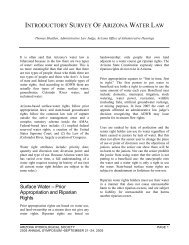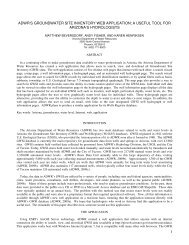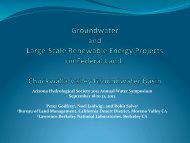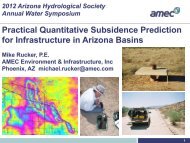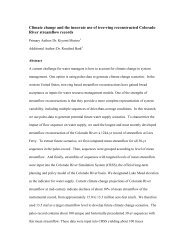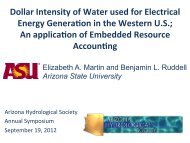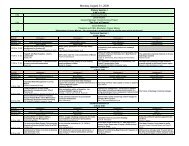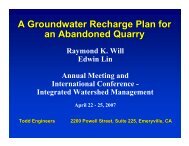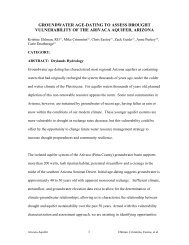Untitled
Untitled
Untitled
You also want an ePaper? Increase the reach of your titles
YUMPU automatically turns print PDFs into web optimized ePapers that Google loves.
• Coal-fired electric power generation facility in<br />
southern Apache County<br />
• 14 miles north of Springerville, 17 miles south of<br />
St. Johns<br />
• Four generating units with 1,560 MW capacity<br />
• Power generation began in 1981; additional units<br />
added in 1990, 2006, and 2009<br />
• Owned by TEP, Tri-State, and SRP<br />
• Operated by TEP
• Exploration, production, and monitor wells installed<br />
in mid-1970s through late 1980s<br />
• Pilot production wells initially installed in east<br />
wellfield; limited production and poor water quality<br />
• More productive aquifer discovered 7 miles west of<br />
SGS in west wellfield; better water quality<br />
• Eight large-capacity wells installed in 1978<br />
• 11 groundwater monitor wells installed<br />
• Several other non-SGS wells added to monitoring<br />
program
• The principal rock units in the SGS area:<br />
Quaternary alluvial deposits along streams and drainages<br />
Tertiary and Quaternary volcanic flows<br />
Tertiary sedimentary rocks (Datil, Bidahochi, Eagar<br />
Formations)<br />
Triassic Chinle and Moenkopi Formations<br />
Permian Kaibab Limestone<br />
Permian Coconino Sandstone<br />
Permian/Pennsylvanian Supai Formation<br />
Precambrian granitic bedrock<br />
• Kaibab and Coconino comprise aquifer for SGS wells
• Older sedimentary rocks dip regionally to northeast<br />
• Dip not uniform due to faults and folds which are<br />
perpendicular to regional dip<br />
• SGS wellfield areas are on Antelope Valley anticline<br />
• Antelope Valley fault runs parallel to the anticline<br />
and lies between east and west wellfields<br />
• Vertical offsets along fault are several hundred feet
• SGS east wellfield on upthrown (NE) side of fault<br />
Wells P-1 through P-6<br />
Kaibab unsaturated; groundwater in Coconino only<br />
Small well yields and low hydraulic conductivity<br />
Not used for water supply<br />
• SGS west wellfield in structural trough on downthrown<br />
(SW) side of fault where rocks are more fractured and<br />
permeable<br />
Wells P-7 through P-20<br />
Kaibab and Coconino both contain groundwater<br />
Large well yields and very high hydraulic conductivity<br />
Provide all water supply for SGS facility
• Depth to groundwater level in SGS wellfields<br />
ranges from 600 to 750 feet<br />
• Groundwater elevations in study area range from<br />
~6,300 feet msl near SGS facility to ~5,600 feet<br />
msl near St. Johns<br />
• Groundwater elevation in SGS west wellfield<br />
averages about 5,890 feet msl<br />
• Regional direction of GW movement to northwest<br />
• In west wellfield, direction of GW movement is<br />
perpendicular to fault and toward the wellfield<br />
trough
• SGS east wellfield<br />
Transmissivity ranges from 200 to 1,750 ft 2 /day<br />
Pumping rates 135 to 465 gpm<br />
TDS 2,300 to 2,700 mg/L<br />
Unused<br />
• SGS west wellfield<br />
Transmissivity ranges from 13,000 to 1,500,000 ft 2 /day<br />
Pumping rates 1,000 to 2,200 gpm<br />
TDS 850 to 2,200 mg/L<br />
Provides all water supply for SGS (~19,400 AF/yr)
• In 1994, extensive carbon dioxide-helium reservoir<br />
discovered<br />
• Gas field explored and developed in late 90s/early<br />
2000s<br />
• The gas reservoir occurs mainly within certain units<br />
of the Supai Formation (below SGS aquifer)<br />
• Gas field covers 275 square miles<br />
90% CO 2<br />
6% N 2<br />
0.6% He<br />
• SGS wellfield located near SW edge of gas field
• Original wells built with mild steel casings<br />
• By 1990s, steel casings disintegrated from corrosion<br />
Coconino intervals collapsed<br />
Kaibab intervals had open boreholes<br />
Wells remained functional<br />
Suspected that corrosion was result of dissolved CO 2 (carbonic<br />
acid) in groundwater<br />
• During 2002-2008, replaced all 7 production wells and<br />
drilled 6 new wells in the west wellfield<br />
Portions of wells below water level constructed with 304<br />
stainless steel casing/screen<br />
Portions above water level considered less susceptible to<br />
corrosion; constructed with copper-bearing steel casing<br />
• In general, video scans have shown that the stainless steel<br />
well casings have experienced no corrosion or scaling
• Pump failure at well P-7A from rust particles<br />
• Recent video scans of showed the upper non-stainless<br />
casings above groundwater level were badly corroded at<br />
wells P-7A and P-12A and slightly to moderately corroded<br />
at P-15<br />
• Similar corrosion pattern at other wells not yet observed<br />
• Stainless intervals have no corrosion<br />
• Suspected means of upper casing corrosion:<br />
CO 2 degassed from groundwater and accumulated in upper<br />
wellbore<br />
CO 2 combined with water vapor and/or condensate in upper<br />
casing, forming H 2 CO 3<br />
Acidic solution then acted as corrosive agent
• To investigate and confirm, depth-specific sampling<br />
conducted at wells P-7A and P-14A to determine<br />
presence and distribution of CO 2 in air in upper<br />
wellbore and in groundwater in lower wellbore<br />
• Using ¼” flexible tubing and vacuum pump, purged<br />
tubing and obtained samples of wellbore gas at<br />
selected depths<br />
• Took readings of gas concentrations using hand-held<br />
gas analyzer<br />
CO 2<br />
H 2 S<br />
O 2<br />
CH 4
• Wellbore Gas Samples at P-7A<br />
CO 2 concentrations averaged 7 percent, compared to<br />
atmospheric average of 0.04 percent<br />
O 2 concentrations averaged 9 percent, compared to atmospheric<br />
average of 21 percent<br />
Elevated CO 2 and depleted O 2 consistent with observed corrosion<br />
• Wellbore Gas Samples at P-14A<br />
CO 2 concentrations 19 percent<br />
CO 2 and O 2 concentrations suggest minimal, if any, reaction with<br />
steel; consistent with observed casing condition
• Depth-specific groundwater samples in 2004 and 2012<br />
indicate CO 2 increases with depth<br />
P-7A CO 2 = 31 – 37 mg/L<br />
P-14A CO 2 = 31 – 130 mg/L<br />
P-15 CO 2 = 65 – 1,130 mg/L<br />
P-16 CO 2 = 66 – 873 mg/L<br />
• Wells P-15 and P-16 penetrated upper part of Supai<br />
• Wells P-7A and P-14A completed above Supai
• Groundwater samples obtained from SGS wells at<br />
wellheads<br />
• CO 2 concentrations ranged from 61-270 mg/L<br />
• TDS concentrations ranged from 840-2,240 mg/L<br />
• Graphical analysis indicates correlation between CO 2<br />
concentrations and other constituents and parameters
• Original production wells constructed with mild steel<br />
casing; substantial corrosion<br />
• New wells and replacement wells constructed with<br />
stainless and copper-bearing steel casings; no corrosion<br />
of stainless steel<br />
• Copper-bearing blank steel casing above groundwater<br />
experiencing corrosion in some wells<br />
• Depth-specific sampling of wellbore gases at some wells<br />
suggests corrosion caused by offgassing of CO 2 from<br />
groundwater recombining with vapor or condensation in<br />
wellbore
• Wellhead groundwater sampling indicates CO 2 concentrations<br />
correlate well with:<br />
TDS – Strong, direct correlation<br />
pH – Strong, inverse correlation<br />
Temperature – Weaker, direct correlation<br />
Distance from fault – Logarithmic, inverse correlation<br />
• TDS and pH good predictors of CO 2 concentrations in<br />
groundwater<br />
• Fault zone predominant pathway of CO 2<br />
• CO 2 has substantial impact on groundwater quality and<br />
corrosive effect on steel casings<br />
• Corrosion avoided by constructing wells entirely of stainless<br />
steel, or by replacing or lining upper casings with stainless



